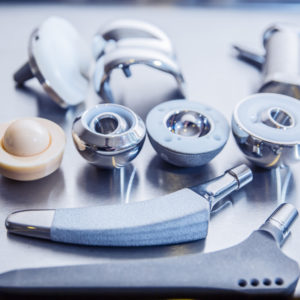DePuy Settles ASR Hip Lawsuits for $4B: Bloomberg

Sources are reporting that Johnson & Johnson has agreed to pay more than $4 billion to settle thousands of product liability lawsuits over the DePuy ASR hip replacement system, which was recalled in 2010 amid high failure rates.
The DePuy ASR settlement was reported by Bloomberg News, citing three unnamed sources familiar with the deal.
The agreement would resolve more than 7,500 cases. Neither Johnson & Johnson nor its DePuy Orthopaedics subsidiary have confirmed the deal.

Learn More About
Lawsuits are being reviewed for several different dangerous and defective hip replacement systems.
Learn More About this Lawsuit SEE IF YOU QUALIFY FOR COMPENSATIONIf true, sources said that the company would pay an average of $300,000 to patients who had to undergo revision surgery due to the DePuy ASR artificial hips failing or because of metal blood poisoning which forced them to have it removed due to pain and other complications. A previous proposed settlement would have paid about $200,000 per case, but that was reportedly rejected by plaintiffs as providing inadequate compensation for the injuries.
To date, the company has spent an estimated $993 million related to the DePuy ASR hip recall, which was first announced in August 2010. At the time, DePuy Orthopaedics said the systems had a 12-13% failure rate. Since then, some analysts have looked at hip implant registries in the U.K. and estimated that the DePuy ASR failure rates may exceed 30% after six years.
Even if the settlement reports are accurate, the company would still face thousands of claims that may go to trial. The company faces nearly 12,000 DePuy ASR hip lawsuits in state and federal courts throughout the country involving allegations that design defects with metal-on-metal hip replacement increased the risk that users would experience problems with their artificial hip within a few years after it was implanted.
DePuy ASR Hip Problems
The troubles with the DePuy ASR implants were the vanguard in the decline of the use of metal-on-metal hip replacement systems worldwide. Before the recall, the design, meant to be more resilient and implanted in younger, more active recipients, was on the rise in the orthopedic community. After, as more problems with the metal-on-metal design came to the forefront, sales of the devices dropped and many health experts have advised against their use or restricted them.
The problem appears to be with the metal socket-and-ball design. Experts say that the chromium and cobalt parts shed debris as they rub together, which can lead to a form of metal blood poisoning known as metallosis, and can cause damage to the implants themselves that lead to fracturing and catastrophic failure.
Last month, the National Institute for Health and Care Excellence (NICE) in the U.K. issued a draft guidance requiring that all hip replacement systems have a 5% or less failure rate over 10 years. The move is being seen as a complete ban on metal-on-metal hip replacement systems in the U.K.’s nationalized health care system since none of them would meet that requirement.
Earlier this year, British members of Parliament called for a criminal probe into Johnson & Johnson’s actions regarding the DePuy ASR, as information has come to light suggesting that the company knew the hip implants posed a risk of metal toxicity and increased failure rates, but continued to sell them without providing doctors or patients adequate warning.
DePuy ASR Litigation Status
While thousands of cases are pending, a small number of lawsuits have been set for early trial dates in state and federal courts to help the parties gauge how juries are likely to respond to certain evidence and testimony that may be repeated throughout a large number of claims.
Earlier this year, a California jury awarded $8.3 million in damages in one case. However, a second trial held in Illinois state court resulted in a defense verdict for the manufacturer.
In October, two DePuy ASR cases settled, one during the start of the trial and the other right before trial was set to begin. All of those cases were at the state level.
In the federal court system, all DePuy ASR litigation is consolidated for pretrial proceedings before U.S. District Judge David A. Katz in the Northern District of Ohio, where the first “bellwether” trials are expected to begin in January 2014. The bellwether trials in the federal court system were originally set to begin in September, but the first case has been postponed at least two times, leading to speculation that the parties may be considering a settlement.
In New Jersey state court, the next DePuy ASR trial was also expected to begin in January 2014, involving a consolidated trial for two different individuals who have experienced similar problems following DePuy hip replacement surgery.
Get more articles like this sent directly to your inbox.
"*" indicates required fields






0 Comments